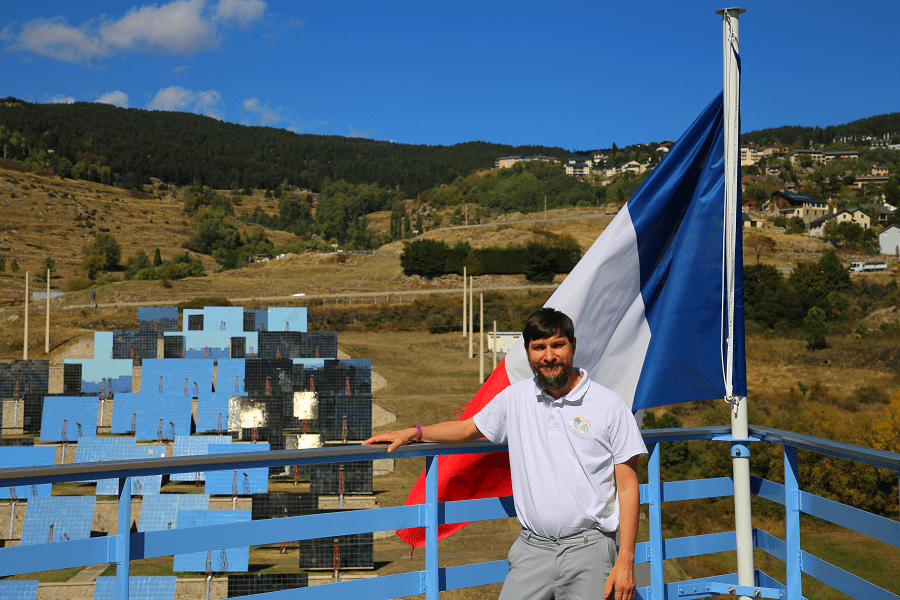IT IS QUITE LIKELY THAT THE 21ST CENTURY WILL REVEAL EVEN MORE WONDERFUL INSIGHTS THAN THOSE THAT WE HAVE BEEN BLESSED WITH IN THE 20TH. BUT FOR THIS TO HAPPEN, WE SHALL NEED POWERFUL NEW IDEAS, WHICH WILL TAKE US TOWARDS SIGNIFICANTLY DIFFERENT DIRECTIONS FROM THOSE CURRENTLY BEING PURSUED. PERHAPS WHAT WE MAINLY NEED IS SOME SUBTLE CHANGE IN PERSPECTIVE—SOMETHING THAT WE ALL HAVE MISSED . . . .
ROGER PENROSE, THE ROAD TO REALITY: A COMPLETE GUIDE TO THE LAWS OF THE UNIVERSE, ALFRED A. KNOPF (PUBLISHER), 2005. PAGE 1045.
Sergei Sergeevich Kokarev graduated from the faculty of physics at the Moscow State University in the year 1993, he is a PhD candidate of physics and mathematics, director of the Logos Regional Scientific and Educational Center in Yaroslavl, Russia. He published nearly 100 scientific and methodical works in domestic and foreign editions. He wrote “Vectors in Physics”, “General Theory of Relativity”, “Physics of Bowling”, “Physics marathon”, “2-dimensional Algebra Geometry and Physics” (preparing for publication).
Sergei Kokarev “Matter imitation by the scalar field in the 5-dimensional Kaluza–Klein theory” PhD thesis on the theoretical and mathematical physics was devoted to the 5-dimensional generalization of Einstein’s General Theory of Relativity and research on the possibility of the geometrization of matter within its framework. His current research interest areas are physical-geometric and algebra-physical unified theories, physics in space-time with complex coordinates, Finsler extensions of physical theories, philosophical problems of physics and mathematics.
Sergey, tell me why you became a physicist?
I think that the subjective basis of any scientific search is surprise and delight. In science, the ability to be surprised is transformed into the ability to see the unusual in the ordinary and at least sometimes change the point of view on familiar things. Enthusiasm turns into a bright feeling of harmony that opens somewhere at the final stages of scientific research.
Personally I got lucky at least three times in this aspect. Firstly, in my childhood, I heard an amazing story about atoms and molecules, and it left me with a strong impression of a mystery that remains with me to this day. Since that time I have firmly decided to study physics, and I have the opportunity to practice it to this day. I had the opportunity to communicate with many, very different, interesting people of science: sometimes I learned from them “to do physics”, but more often I just came into contact with the worlds of their scientific ideas, and as a result I found new — often opposite — ideas in my personal world. The communication was sometimes very intense in this regard: new thoughts, notes, or articles were born.
And which of the science people had the most significant influence on you?
One of the last bright influencers of this kind is Sir Roger Penrose through his books (R. Penrose, The Emperor’s New Mind: Concerning Computers, Minds and The Laws of Physics, 1989, R. Penrose, Shadows of the Mind: A Search for the Missing Science of Consciousness, 1994. R. Penrose, The Road to Reality: A Complete Guide to the Laws of the Universe, 2005), and my personal contact with him during his stay in Russia in March-April 2013. The above mentioned books by R. Penrose, of course, are among the popular ones, but they are by no means simple, the popularization of ideas in them is not achieved by sacrificing accuracy, but by providing a deep understanding of the problems and the talent of the author as a scientist and popularizer of science. These books are written in such a way that any reader will find in them abundant food for his own thoughts.
When I started to read his books, I prepared a special notebook in which, as I read, I made drafts of future lectures for schoolchildren and students as well as for scientific and scientific-methodological articles, following those of my own ideas that “resonated” with the book’s material. A personal acquaintance with Sir Roger Penrose did only strengthen the effect of his books: his demeanor, and simplicity, combined with a depth of understanding of the subject and the interlocutor. Personal modesty and human charm create an indelible impression of the integrity of his personality and his scientific position.
I remember our meeting with Penrose at the Moscow Conservatory. Tell us about your meeting with him.
Yes, I had an additional experience, speaking at a seminar with Roger Penrose on April 3, 2013 at PFUR, outlining the general ideas of poly-number field theory.
Video of the speech and commentary on it of R. Penrose available at the links:
R. Penrose provided additional comments at the press conference:
The printed version of these videos (along with two Penrose lectures and a report by S. V. Siparov) is presented in the Hypercomplex Numbers in Geometry and Physics Journal (special issue devoted to the visit of Sir Penrose to Russia in March-April, 2013), 1 ( 19), Vol.10 (2013). In his commentary, Sir Roger Penrose, in particular, says that “… the work that I do goes in a certain way in the opposite direction to what you are doing … It is very important that such things be done and it is important that develop different directions and get a more general understanding of how these things are connected … ”
After the workshop, I approached him and asked:
– Maybe our different paths intersect somewhere? Or even lead to the same thing?
He smiled, paused, and then replied:
– Yes, it is quite possible that somewhere at infinity they have a common point and talk about the same …
The theme of common points is interesting and important. Even professional physicists often do not immediately understand each other …
Roger Penrose understood everything quickly and correctly. Apparently, starting from a certain level of professional skills, depth of understanding and outlook, the barriers disappear …
Yes, but they remain with an unprepared audience. Let’s talk about “common points” …
It seems to me that this, today barely distinguishable topic of the “common point” (or, perhaps, “common points”) as the semantic focus of various areas of thought of modern theoretical physics, is very relevant in the context of the colossal differentiation of modern sections of physics and mathematics.
Of course, the subject of “common point” is very broad and includes many areas. I propose to open it with a general discussion on two very different ways in which physical theories can develop in principle.
The physics history reveals that the change of physical theories can occur in two different scenarios. According to the first, the new theory replaces the old one in the form of its generalization. In this case, the old theory is obtained from the new as a certain limiting subcase. A generalized theory can take us to a new conceptual level of understanding of reality, which, generally speaking, requires a new conceptual and mathematical language. But in passing to the limit of the old theory, new concepts of the generalized theory are transformed into concepts of the old one according to the rules, which are sufficiently transparent and mathematically easily formalized.
Thus, generalized theories can be understood as a certain kind of deformation of the old theories: sometimes a new physical quantity or even a fundamental constant is used as a “deformation parameter”, reflecting those new properties of physical reality, the description of which is claimed by a corresponding generalization.
That is, physical theories can also be “defamed” like plasticine? And can you give examples of such a deformation?
The analogy with plasticine is correct only in a certain sense. But the term “theory deformation” can be given an exact mathematical meaning, and then quotes can be removed. Typical examples of generalization scenarios are transitions from Newtonian mechanics to the special theory of relativity and from the special to the general theory of relativity. In the first case, the deformation parameter is the light speed c: a nonrelativistic limit corresponds to a transition (sometimes requiring diligence) c → ∞. In the second case, as a “deformation parameter” one can consider a set of variables for immersion of the Minkowski world sheet in a flat multidimensional space-time (S. S. Kokarev, Space-time as multidimensional elastic plate, Nuovo Cimento B113 (1998) pp. 1339-1350).
We talked about the first scenario. Is there a second one?
The second scenario of the change of physical theories consists in a cardinal change of the physical paradigm, which presupposes the description of reality within the framework and terms of the concepts, generally speaking, which are not reduced to the concepts of the old theory for any limiting process. In this case, the new theory gives us a fundamentally new language, which may not even remotely resemble the language of the old theory.
The fact that alternative theories claim to describe the same set of observable phenomena means that there must exist a morphism (similarity congruence) between their languages: adherents of an alternative theory should, in principle, be able to formulate rules for translating their concepts into the language of the concepts of the original theory. In this case, we, generally speaking, do not have the opportunity to consider an alternative theory as a deformation of the old, understood in any sense.
As examples of alternative theories, we present Wheeler-Feynman long-range electrodynamics (an alternative to Maxwell electrodynamics, Yu.S. Vladimirov, A.Yu. Turygin, Theory of Direct Interparticle Interaction, M. Energoizdat, 1986), Logunov’s relativistic theory of gravity (alternative to Einstein GR, A. A. Logunov, Lectures on the Theory of Relativity and Gravity. Modern Problem Analysis. M. Nauka, 2005), superstring theory (alternative to the standard model of particle physics, R. R. Metsaev, String Theory as the Basis for a Unified Field Theory and a Description of the Strong Coupling Regime of Gauge Theories, In Proc. Works of the I.E. Tamm seminar, editors M.R. Vasiliev. L.V., Selikhatov, M.: Keldysh, A.M. Nauchnyi Mir, 2007, p. 5-52).
The following comparative table summarizes the characteristic features of generalized and alternative theories.
| Specifications | Generalized Theory | Alternative Theory |
| Motivation | Boundaries Extension | Description Unification |
| Design Method | Old Theory Deformation | New Paradigm and Language |
| Conformity Principle | Ultimate Deformation | Morphism Dictionary |
| Experiment Role | Decisive | Indirect |
And what does the last line mean in this table? Does it mean that experiment is not important in an alternative theory?
No, it is important, but perhaps not at the stage of formulating a theory. For example, the modern standard model of elementary particle physics is semi-phenomenological, that is, roughly speaking, half of it relies on a rather abstract mathematical basis (the theory of gauge fields in bundles over some Lie group), but the filling of this basis is taken from time-consuming experiments on accelerators or observations over particles in cosmic rays. At the same time, in the standard model there are about 20 parameters, that are not calculated, but are simply taken from the results of comparing theory with experiment.
On the other hand, the theory of superstrings is, in a sense, self-sufficient and, I would say, Neo-Pythagorean geometrical-physical theory, in which you don’t really add or remove anything. Almost everything is calculated in it, even the dimension of space-time, but this self-sufficiency has a downside, the theory of superstrings predicts the existence of many particles that have not been experimentally detected yet.
And what is the usual scenario of the evolution of physics?
Nothing is easy here, life is always more difficult than any scheme! First, it should be noted that the transition to a new theory by means of generalization can in a certain sense be viewed as a “normal” scenario for the development of physics, it reflects the progressive continuous development of scientific knowledge, it includes the principle of continuity and therefore is conceptually, technically and even psychologically more comfortable for the researcher.
On the contrary, the scenario in the direction of the alternative theory reflects the jump-like component of development, it includes the principle of continuity, perhaps only in an indirect form, it often requires new rules of thinking about the world and new mathematics and therefore causes some discomfort to most researchers.
Roger Penrose in his book “The Road to Reality …” very carefully describes this situation in the following words: “The apparent subjectivity that we see in the strong influences of fashion, referred to above, are simply features of our gropings for this understanding, where social pressures, funding pressures, and (understandable) human weaknesses and limitations play important parts in the somewhat chaotic and often mutually inconsistent pictures that we are presently confronted with”.
Secondly, it should be understood that in reality the “generalization” – “alternative” dilemma represents only two extreme poles for scenarios that are extremely rare in their pure form.
In the real historical perspective of the past, we are confronted with theories that in relation to previous theories, are a peculiar symbiosis of generalized and alternative theories. Thus, the general theory of relativity is not just a generalization of the special, but also an alternative to the Newtonian theory of gravity. Indeed, in GTR, instead of the gravitational force and Newton’s second law, purely geometric objects appear: metric, connection, and the equations of geodesics.
Wheeler-Feynman long-range electrodynamics are both an alternative and a generalization of Maxwell electrodynamics. The first is due to the fact, that in the long-range formulation the electromagnetic field is a secondary (auxiliary) concept, which in the framework of this theory can even be mentioned.
On the other hand, Wheeler-Feynman electrodynamics is a whole family of theories that differ from each other by absorption conditions at infinity, Maxwell causal electrodynamics corresponds to an absolute absorber in the remote future.
Electrodynamics without an electromagnetic field – it sounds like something unexpected and even … defiant. Is this really possible?
Yes, I suggest we talk about it next time.
Interview: Ivan Stepanyan











